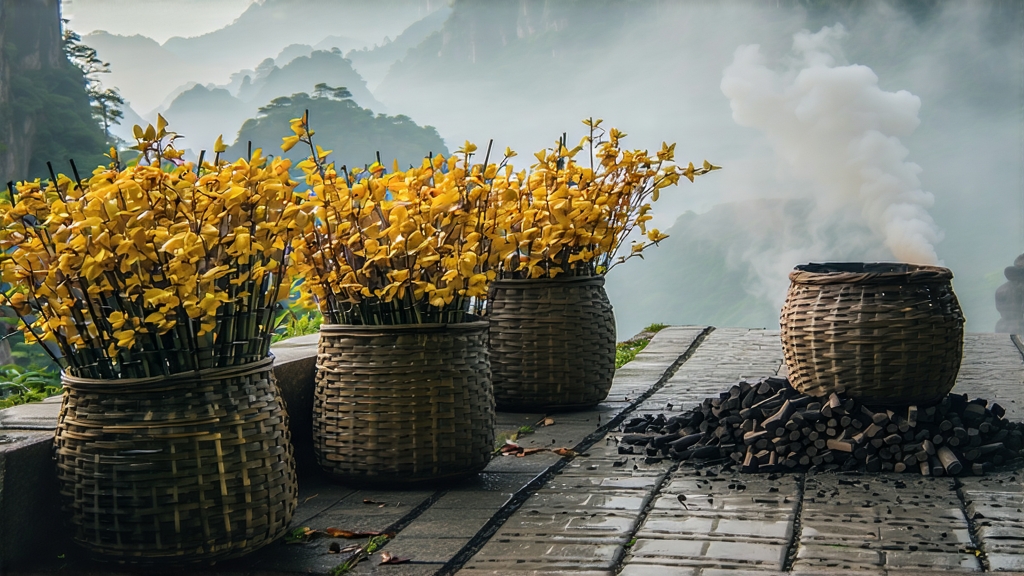
Tucked high in the mist-veiled Dabie Mountains of western Anhui Province, Huoshan Huangya has quietly captivated Chinese emperors, poets, and tea sages for more than fourteen centuries. Today this “Imperial Yellow Bud” remains the most prestigious representative of China’s smallest and most elusive tea family—yellow tea—yet outside the Middle Kingdom it is still whispered about rather than widely known. The following portrait is written for the international tea traveler who wishes to understand why a leaf can taste like warm chestnut, mountain orchid, and fresh cream all at once, and why its craft is considered more difficult to master than that of any green, white, or oolong sibling.
-
A leaf born of tribute
The first written record appears in the Shennong Bencao Jing (Divine Farmer’s Materia Medica) of the Han era, but Huoshan Huangya’s golden age began under the Tang dynasty (618-907) when it was designated gongcha—tribute tea—sent each spring to Chang’an in yak-hide pouches lined with lotus leaves. During the Ming, imperial inspectors rode three days nonstop from Nanjing to secure the first harvest, believing the bud’s “three yellows”—yellow-green leaf, bright yellow liquor, and canary-yellow leaf bottom—mirrored the emperor’s dragon robes and therefore Heaven itself. When the Qing court switched to compressed dark teas for easier transport, Huoshan Huangya almost vanished; only a handful of Buddhist monks on Jinzhai Peak kept the seed stock alive. The 1973 state-led restoration project grafted ancient trees onto newly terraced gardens at 600–800 m, and the cultivar now thrives as a protected geographical indication (PGI) of Huoshan County. -
The yellow tea family and Huoshan’s place within it
Chinese taxonomy divides yellow tea into three regional styles:- Bud yellow teas—single-bud picks such as Junshan Yinzhen from Hunan’s Dongting Lake and our protagonist Huoshan Huangya.
- Leaf yellow teas—one-bud-one-leaf or one-bud-two-leaf like Mengding Huangya from Sichuan.
- Large-leaf yellow teas—compressed post-fermented cakes from Guangdong and Anhui’s southern mountains.
Huoshan Huangya is therefore the northernmost and highest-altitude bud yellow tea, giving it a tighter amino-acid profile and a cooler, pine-fresh aroma compared with the lake-influenced sweetness of Junshan Yinzhen.
- Micro-fermentation: the art of menhuang
What separates yellow from green tea is not oxidation in the oolong sense but a controlled enzymatic yellowing called menhuang—“sealing yellow.” After picking, the buds must never be rushed; they are left to breathe overnight in thin bamboo trays so that surface moisture evaporates without mechanical withering. The next dawn begins a sequence unique to each master:
a) 80 °C pan firing for 4–5 minutes, just enough to halt grass-green enzymes while preserving inner moisture.
b) Hot wrapping: the still-warm buds are scooped into five-layer linen bags and buried inside a charcoal-heated bamboo bucket (wen huang xiang) at 45 °C for 40 minutes. This “first seal” coaxes chlorophyll to degrade into pheophytin, turning the leaf jade-gold.
c) Re-firing at 70 °C to re-fix the new color, followed by a second menhuang of 30 minutes at 38 °C.
d) A third, gentler firing shapes the bud into a straight, slightly open needle.
e) Final low-temperature desiccation over charcoal embers imparts the signature chestnut note.
The entire cycle spans three days and demands that the craftsman read the leaf’s aroma like a musical score: too little heat keeps the tea green; too much drives it into light oolong territory. Masters claim they can judge the exact second to unwrap by pressing an ear to the bamboo—when the buds stop “singing” (a faint crackle) menhuang is complete.
- Terroir in a cup
Huoshan County lies on the northern edge of China’s subtropical zone. Morning clouds rise from the Pi River and collide with cold air from the Dabie massif, creating 240 foggy days a year. The soil is Phyllite weathered granite—mineral